Puget Systems Serenity SPCR Edition: Blissful Silence
by Dustin Sklavos on February 10, 2011 12:00 AM EST- Posted in
- Systems
- Intel
- Radeon
- Sandy Bridge
- Puget Systems
- Serenity SPCR
Gaming Performance
It's not going to surprise anyone to see the Puget Serenity take last place in all of these tests; the second-slowest gaming system we've reviewed sports a Radeon with more than twice the number of stream processors, more than twice the memory bandwidth, and higher clocks to boot. That said, many of the really high scores we've seen are largely academic: can anyone really tell the difference between 100 frames per second and 150? Without getting into the ridiculous argument of whether or not the human eye can see more than 30 frames per second (if it's not supposed to be able to, I'm pretty sure most of the video geeks in the readership—myself included—are superhumans), that framerate should still be your baseline for acceptable performance.
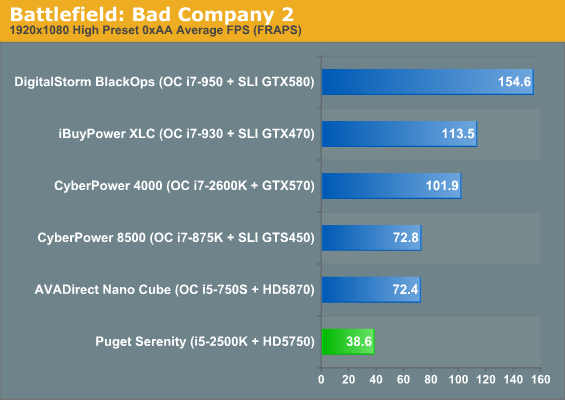
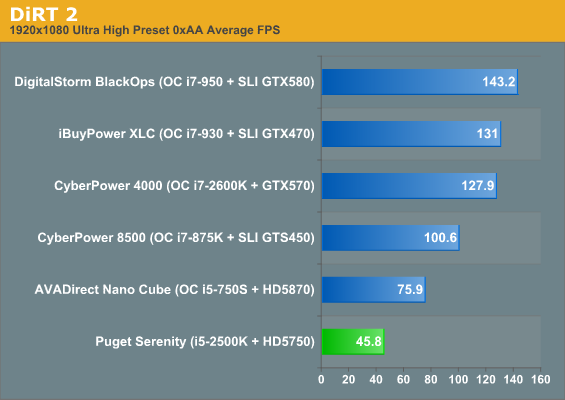

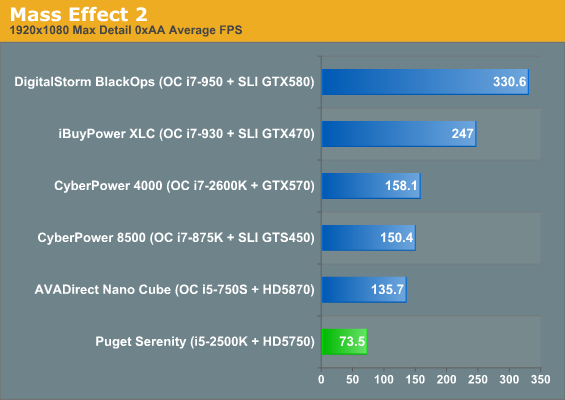
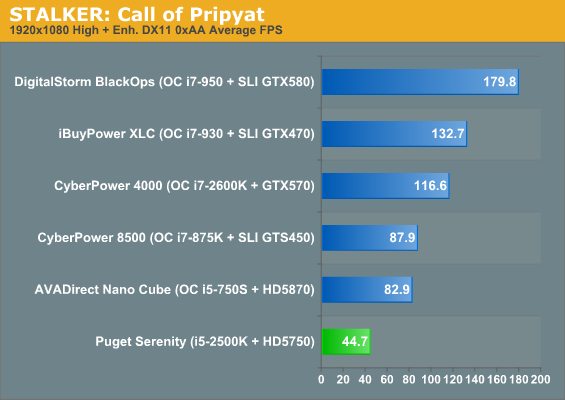
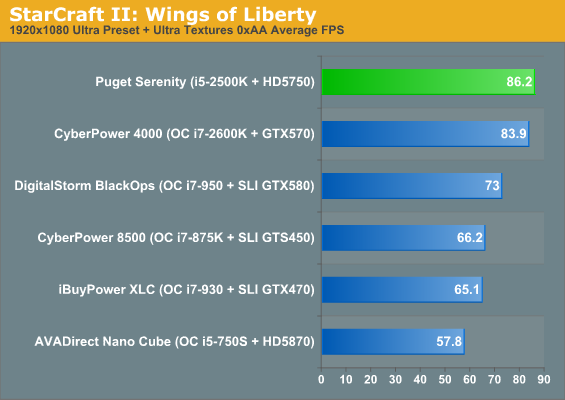
Outside of the stunningly CPU-limited StarCraft II, Puget Systems's Serenity is able to at least beat the 30fps mark by a fairly healthy margin. I like to see framerates in at least the forties to ensure smooth gameplay, but any of these games are perfectly playable at our "High" preset, which is basically running them at maximum or near-maximum (as in the case of Call of Pripyat) settings, 1080p, and no anti-aliasing (excepting Left 4 Dead 2). Knowing that we're a little bit close to our ceiling, let's see what happens when we do kick anti-aliasing in with our "Ultra" preset.
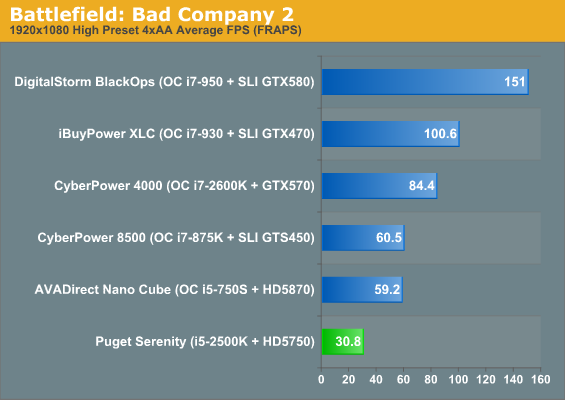
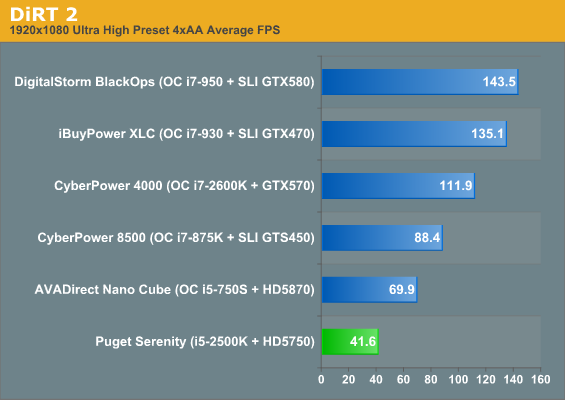
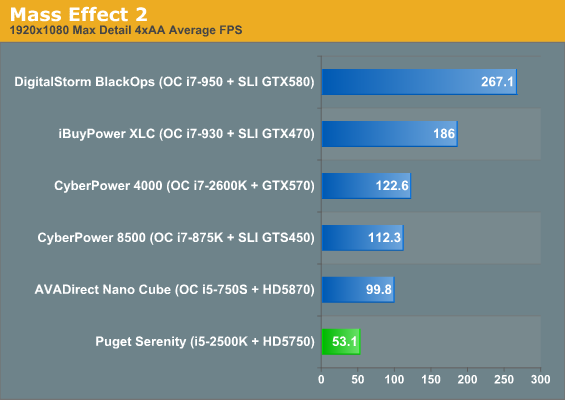

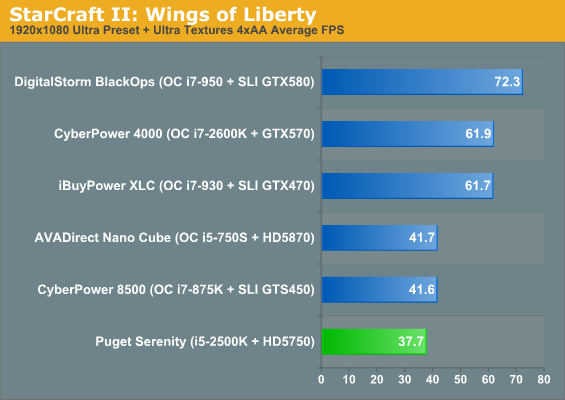
Battlefield: Bad Company 2 is pushing its luck and Call of Pripyat is fairly punishing even on our other systems, but for the most part these games (outside of Call of Pripyat) remain playable and fluid. Shifting the bottleneck back to the video card in StarCraft II sends the Serenity tumbling back to the bottom of the heap, but even then it's still very playable. Gamers looking for extra frames may want to disable anti-aliasing in that title anyhow, as the image quality difference is negligible when the performance impact is taken into account. Suffice it to say these settings are basically the threshold for the Radeon HD 5750, and while performance is good, the 6850 is going to be a welcome upgrade.










139 Comments
View All Comments
pcfxer - Thursday, February 10, 2011 - link
RTA analysis + anechoic chamber time = engineering.They hand picked the fans, coolers, etc. to work together based on what they believed to be appropriate compromises.
Let's take your simpleton description to another analogy.
"Engineering? They took some bolts, some plastic, motor oil, a few sensors to fit inside a mustang body! Damn them and their highly efficient 5.0L with more horsepower than a base Corvette!"
Like I said, some of you just don't get what Engineering is.
FunBunny2 - Thursday, February 10, 2011 - link
Don't be so quick to jump on that bandwagon. OCZ has been getting a lot of heat over its Vertex 2 parts built with 25nm NAND. A topic you should pursue, by the way.bigbob123456 - Thursday, February 10, 2011 - link
Speaking from experience, I can tell you that's the most half-assed foam installation. First that's a cheap medium density foam. Quality would mean using 1/4" neoprene, which costs 3x as much as what they used. Second, they're making a mistake in cutting slots in the foam for the structure of the case...it's FOAM it'll compress to compensate. Third, they could have used 3x as much foam as they did. I see lots of exposed metal at the back of the case, around the motherboard, on the drive cage, etc.I recently bought some foam and did my own installation, and every square inch you cover beyond just the front / sides does make an audible difference. In a lot of places I even doubled up on the foam.
HangFire - Thursday, February 10, 2011 - link
"I recently bought some foam and did my own installation, and every square inch you cover beyond just the front / sides does make an audible difference."Wow, impressive. So how much lower than 11db did you get? And how is it you could actually hear the difference below 11db? Are you an Owl?
Or maybe... once PS got to 11db... they knew they could stop right there?
bigbob123456 - Thursday, February 10, 2011 - link
Obviously I did my own installation in a normal game box, subjectively cutting the noise level in half. The point is it speaks to the level of overpricing on this machine given the quality (lack of) they put into it. For example, if they would have done some better foaming they probably could have thrown in a 6870 or something instead of a useless 5750 and had the same results. Duh.HangFire - Tuesday, February 15, 2011 - link
Puget Sound does make gaming systems. Anandtech didn't review of them them. D'oh.MeanBruce - Thursday, February 10, 2011 - link
I guess you can purchase a PC like this one and let someone else decide and define a silent PC for you. But for $2200 you can build a much quieter and much higher performing and much better looking PC than this Puget. Corsair AX850 is a much better psu than this Antec, Noctua NH-D14 is a much better CPU cooler than the Gelid, and the Asus 6870 direct cu is a much better video choice than the 5770. Do some research put some time into it learn a great deal and pay yourself in better components instead of paying Pugit for assembly costs!Wrap all these great parts in a Corsair Obsidian 650D enclosure and run the 6870 fan on auto. It's 10decibels of hardware heaven! Enclose your hardware not your mind!
PartEleven - Thursday, February 10, 2011 - link
I think you have no idea how quiet 10 db really is. The system you described is no where near 10 db.kevith - Thursday, February 10, 2011 - link
You're absolutely right: 10 dB is VERY little sound.MeanBruce - Thursday, February 10, 2011 - link
Oh I know 10db and 8db and 6db. Read my earlier comments on each component, this article. Maybe you are not up on the latest heatsinks by Asus they are huge allowing fans to run at idle 15 percent and stay in the 30s. I know the fan can also produce 30db but I am talking idle and working in Office apps, not gonna argue but the AX850 is dead silent fan does not move under 25percent load and the Noctua NH-D14 I run with no fans passive! Don't assume until you really know!